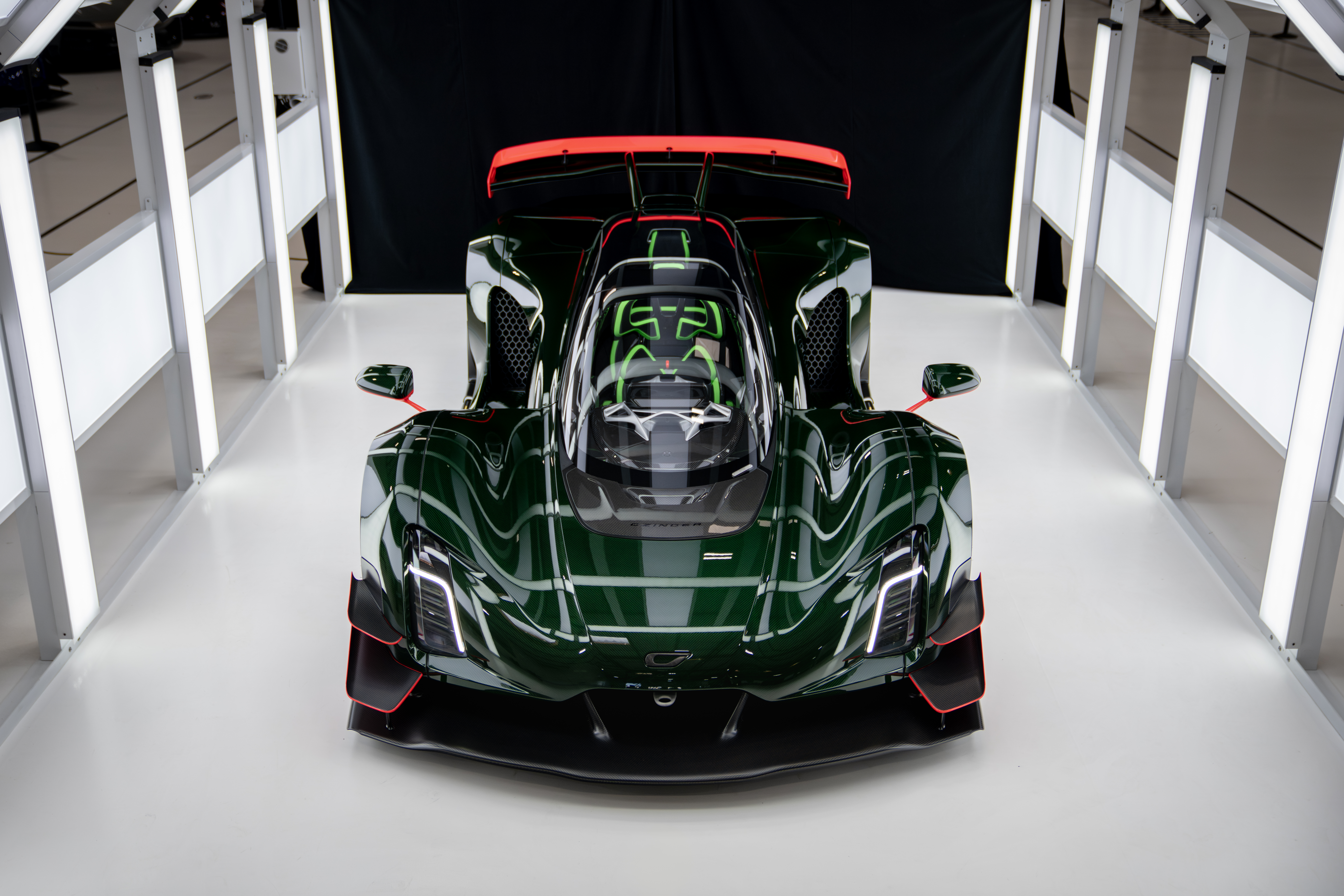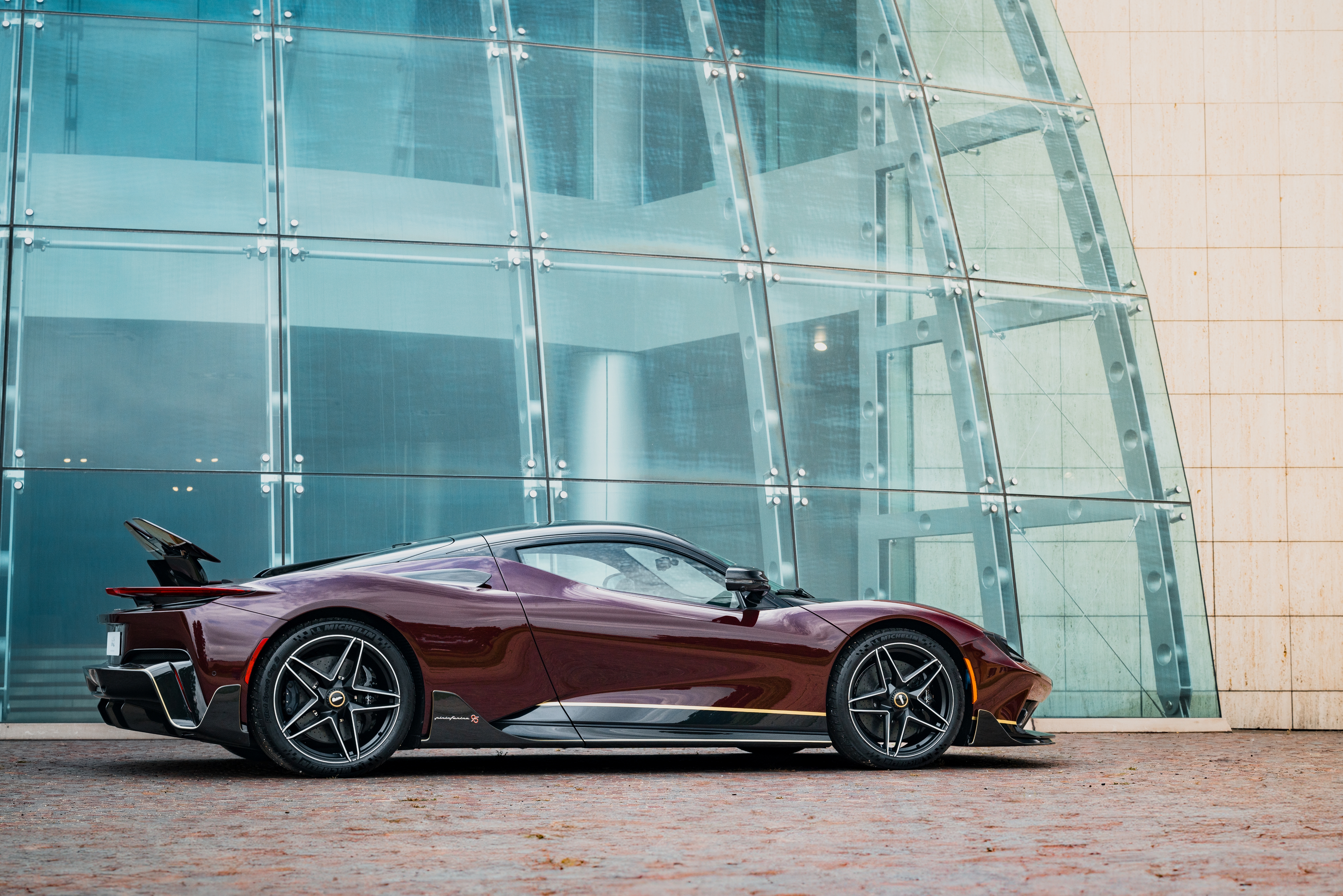Seven-figure EV hypercars are struggling to make an emotional connection with buyers.
Monterey Car Week is an annual celebration of automotive culture at the extremes: extreme performance, extreme rarity, and extreme value. Cars offering more than 1,000 hp (746 kW) are de rigueur, “unique” models are everywhere you look, and machines costing well into seven figures are entry-level.
A few years ago, many of the new cars debuting during Car Week focused on outright speed and performance above all else, relying on electric powertrains to deliver physics-defying acceleration and ballistic speed. Lately, there’s been a shift back toward the fundamentals of driver engagement, emotional design, and purity of feel.
Internal combustion is again at the fore. One of the main reasons is a renewed interest in what was old—so long as that old thing is actually new.
They’re called restomods, classic cars brought up to date with modern drivability but keeping the original feel. LA-based Singer Vehicle Design is the Porsche-based poster child for this movement, but San Marino-based Eccentrica earned plenty of attention in Monterey for its reimagining of one of the ultimate icons of the ’90s, the Lamborghini Diablo.
This is Eccentrica’s restomod of the Lamborghini Diablo. Tim Stevens
The company’s latest creation, Titano, promises “Raw ’90s soul meet[ing] purposeful modern craft.”
Maurizio Reggiani, former Lamborghini CTO and now advisor to Eccentrica, told me that feel is far more important than outright performance in this segment. “We want the people sitting in Eccentrica to really perceive the street, perceive the acceleration, perceive the braking, perceive the steering,” he said.
Commoditization
“The power to have 1,000 hp is easy. I don’t want to say it is a commodity, but more or less,” Reggiani continued.
Eccentrica’s Titano makes 550 hp (410 kW). The machine Bugatti unveiled, the new Brouillard, nearly tripled that number, offering 1,578 hp (1,177 kW) from an 8.3-liter W16 engine paired with a hybrid system. It’s a one-off, a completely bespoke design created at the request of one very lucky, very well-heeled buyer, part of the company’s new Programme Solitaire.
That’s an impressive figure, but Frank Heyl, Bugatti’s director of design, told me the real focus is on creating something timeless. Bugatti has been making cars for 101 years, and today’s astonishing power figures won’t matter in 2126. Instead, Heyl said to focus on the interior. “If you look at the Tourbillon instrument cluster, it’s a titanium housing with real sapphire glass. The bearings are made from ruby stones with aluminum needles,” he said. “People will have a fascination with that in 100 years’ time. I’m sure about that.”
This is the Bugatti Solitaire. Bugatti
For its part, modern Lamborghini seems much happier to focus on the best of the modern era, taking advantage of EV-derived technology paired with an internal combustion engine tasked with providing both power and adrenaline.
Lamborghini unveiled the Fenomeno, a “few-off” version of the Revuelto offered to just 29 buyers. Lamborghini’s current CTO, Rouven Mohr, told me this wasn’t just a reskinning. The company’s engineers re-did the car’s tech stack, including its battery pack, adopting lessons learned from the latest EVs. “Completely new battery hardware. New cell chemistry, new cell type,” he said. “So we double the energy content in the same space.”
It’s similar to what’s in the Temerario, which features a hybrid system paired with a high-strung V8. “This huge effort that we did to have a 10,000-rpm engine is, at the end of the day, engineering overkill,” he said. “It’s a pure investment in the emotional side.”
Lamborghini designer Mitja Borkert said this kind of hybrid tech can actually make the cars more likeable. “Our cars are polarizing; they are creating reactions,” he said, admitting those reactions are sometimes negative. “But if you drive a Revuelto in electric mode, the people can enjoy the design better because it’s unexpected that this spaceship is coming around the corner.”
When it comes to exterior design, Karma is one brand that has always stood out. But its cars, extended-range EVs with onboard generators, have historically struggled to perfect the needed mix of emotionality and electrification. A fix is on the way, CEO Marques McCammon told me. The company’s Amaris coupe, coming next year for roughly $200,000, generates 708 hp (528 kW) from a pair of electric motors, plus a new onboard engine designed to thrill, not just recharge a battery.
“I’ve got side exhaust. It’s real. There’s no synthetic sound. When you hit the throttle, you’re gonna hear a blow-off valve on the turbo, and you’re gonna hear exhaust coming out of the side pipes that we’ve tuned,” he said. “You can have it all.”
You need to hear it
For many, authentic sound is key to the experience. Eccentrica’s Reggiani told me that the synthesized noises emitted by cars like Hyundai’s Ioniq 5 N are not a solution. Reggiani said an EV can never provide a truly emotional experience with sound “because you need to do something fake.”
But Iliya and Nikita Bridan, who run Oilstainlab, might have devised a solution with their $1.8-million-dollar HF-11: a cooling fan for the electric motor run through a ducted exhaust.
That fan exhaust is being tuned and tweaked to create an evocative sound, a process that Nikita Bridan says is no less authentic than tuning the exhaust of a car with an internal combustion engine. Indeed, with many modern sports cars featuring digitally generated pops and crackles in Sport mode, the HF-11’s acoustic affect might be even more authentic.
That’s just part of what Bridan says should be a compelling package, even for anti-EV zealots. “What we’re promising is basically a 2,000 pound, six-speed manual EV with an exhaust. I think that’s interesting enough for people to maybe abandon combustion,” he said.
And the HF-11 has another trick up its sleeve: an air-cooled, flat-six engine (àla classic Porsches), which owners can swap in if they’re feeling old-school. It’s a unique solution to the challenges of shifting consumer demand. So far, about 30 percent of the buyers of the HF-11 are exclusively interested in the electric powertrain. Thirty percent want only internal combustion, while the rest want both.
The Czinger 21C doesn’t have a swappable powertrain, but it mixes electric and internal combustion to deliver outright performance. Very extreme performance, as it were, with the 1,250-hp (932-kW), $2 million (and up) hybrid hypercar taking an extended, 1,000-mile road trip on the way to Monterey, setting five separate track records along the way.
That car’s hallmark is the intricate 3D-printed structure beneath the skin, but despite the space-age tech, CEO Lukas Czinger told me that emotionality is key.

The Czinger C21 features tandem seating. Credit: Czinger
Buyer motivation
“Why would you buy a $3 million car? Well, you’re buying it because you appreciate the brand and the engineering level, and there’s new technology in it, right?” Czinger said. “But the product ultimately needs to be thrilling to drive.”
Czinger said the combination of a hybrid system and an 11,000 RPM twin-turbo V8 offers “the best of both worlds” and that an eventual 21C successor will “definitely have a combustion engine.”
For Automobili Pininfarina, an all-electric powertrain was not a concern for its first car, the $2.5-million, 1,900-hp (1,417-kW) Battista. That’s despite some initial skepticism that, CEO Paolo Dellachà said, evaporates as soon as a potential buyer gets behind the wheel.
But most didn’t need convincing. “All our or our clients do have eight-cylinder, 12-cylinder, or even 16-cylinder engines,” he said. “This is just something additional to their collection. So it’s not one or the other to them. Eventually, it’s both.”

All-electric hypercars like the Battista are a hard sell in 2025. Credit: Automobil Pininfarina
Residuals matter
It’s easy to think that the buyers of these cars simply have bottomless discretionary funds, and many do. But unproven long-term value is a key reason why these battery-powered projectiles seem a little less common than they used to be.
“At the moment, no one has proven yet that the electric super sports car is holding the financial index,” Lamborghini CTO Mohr said. “And the people who are usually investing in this, buying this kind of car, usually they have the money because they are quite financially oriented. They don’t want to destroy their investment.”
In other words, it’s all fun and games until someone loses money. If electric hypercars can’t prove their value in the long run, they don’t have a chance.
This is something that Automobili Pininfarina CEO Dellachà is certainly watching, but he doesn’t seem concerned. “It’s very difficult to say right now because none of our clients yet have sold their car,” he said. “And this is something that, by the way, makes us very proud, because they love the car, they love driving it, or they love keeping in their collection.”
That said, he’s not yet committing to an EV drivetrain for an eventual Battista successor. “Maybe next time we might combine electrification with a combustion engine. We will see. It will be an interesting time to come.”